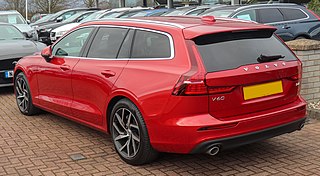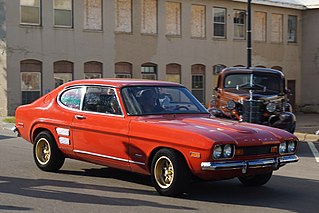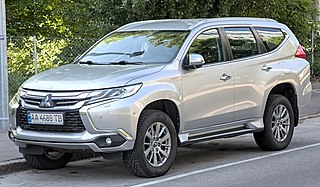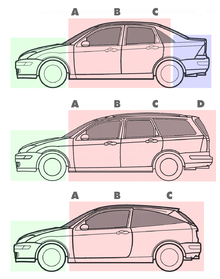
A station wagon or estate car, is an automotive body-style variant of a sedan with its roof extended rearward over a shared passenger/cargo volume with access at the back via a third or fifth door, instead of a trunk/boot lid. The body style transforms a standard three-box design into a two-box design—to include an A, B, and C-pillar, as well as a D-pillar. Station wagons can flexibly reconfigure their interior volume via fold-down rear seats to prioritize either passenger or cargo volume.

A hatchback is a car body configuration with a rear door that swings upward to provide access to the main interior of the car as a cargo area rather than just to a separated trunk. Hatchbacks may feature fold-down second-row seating, where the interior can be reconfigured to prioritize passenger or cargo volume.

A coupe or coupé is a passenger car with a sloping or truncated rear roofline and two doors.

A hot hatch is a fast version of a hatchback car. The term originated in the mid-1980s; however, faster factory versions of hatchbacks have been produced since the 1970s. A front-mounted engine that uses petrol for fuel, together with front-wheel drive, is the most common powertrain layout, however all-wheel drive has become more commonly used since around 2010. Most hot hatches are of European or Asian origin.

In the automotive industry, rebadging is a form of market segmentation used by automobile manufacturers around the world. To allow for product differentiation without designing or engineering a new model or brand, a manufacturer creates a distinct automobile by applying a new "badge" or trademark to an existing product line.

A fastback is an automotive styling feature, defined by the rear of the car having a single slope from the roof to the tail. The kammback is a type of fastback style.

Capri is a nameplate marketed by the Lincoln-Mercury division of Ford Motor Company on three distinct series of automobiles between 1970 and 1994.

Ford Courier is a model nameplate used by Ford since the early 1950s. The Courier moniker has been used on a variety of vehicles all around the world since it was first used in North America for a sedan delivery. The Courier nameplate was also used by Ford for a series of compact pickup trucks and would also see use by Ford of Europe denoting a Fiesta-based panel van. Ford Brazil used the nameplate for a Fiesta-based coupe utility pickup marketed across Latin America.

The Mazda3 is a compact car manufactured by Mazda. It was first introduced in 2003 as a 2004 model, replacing the Familia/323/Protegé in the C-segment.

Automobile was an American automobile magazine published by the Motor Trend Group. A group of former employees of Car and Driver led by David E. Davis founded Automobile in 1986 with support from Rupert Murdoch's News Corporation, using the credo No Boring Cars.Automobile distinguished itself as more of a lifestyle magazine than the other automotive publications, an editorial theme that Davis greatly expanded upon from his tenure as the editor of Car and Driver, though it was a sister publication to Motor Trend.

Body-on-frame, also known as ladder frame construction, is a common motor vehicle construction method, whereby a separate body or coach is mounted on a strong and relatively rigid vehicle frame or chassis that carries the powertrain and to which the wheels and their suspension, brakes, and steering are mounted. While this was the original method of building automobiles, body-on-frame construction is now used mainly for pickup trucks, large SUVs, and heavy trucks.

The Mitsubishi Pajero Sport is a mid-size SUV produced by the Japanese manufacturer Mitsubishi Motors using the Pajero nameplate since 1996 that has spanned over three generations and based on the Triton pickup truck. Mitsubishi has formerly used the Mitsubishi Challenger name in Japan and some international markets, but since the third generation, the Pajero Sport/Montero Sport/Shogun Sport was the name used instead.

The Mitsubishi Pajero is a full-size SUV manufactured and marketed globally by Mitsubishi over four generations — introduced in 1981 and discontinued in 2021.

The Los Angeles Auto Show, also known as the LA Auto Show, is an auto show held annually at the Los Angeles Convention Center in Los Angeles, California, United States. It is open to the public for ten days, filling 760,000 square feet (71,000 m2) of exhibit space. Since 2006 the event is held in November or December.
The Manila International Auto Show is a yearly show for car buyers and enthusiasts alike to look, observe and learn more at the latest models and significant concepts from the Philippines’ premiere auto makers. It is the Philippines’ biggest motor show in terms of visitor count, cars on display, and exhibitors. The show was previously known as The Manila International Motor Show,

Trim levels are used by manufacturers to identify a vehicle's level of equipment or special features. The equipment and features fitted to a particular vehicle also depend on any options packages or individual options that the car was ordered with.

As of 2019, the automotive industry in Thailand is the largest in Southeast Asia and the 10th largest in the world. The Thai industry has an annual output of more than two million vehicles, more than countries such as Belgium, Canada, the United Kingdom, Italy, Czech Republic and Turkey.

The Fiesta Mark IV was launched in October 1995 and became Britain's best-selling car from 1996 to 1998, when it was overtaken by the all-new Ford Focus, a replacement for the Ford Escort.

The automotive industry in the Philippines is the 9th largest in the Asia-Pacific region, with approximately 273.4 thousand vehicles sold in 2019. Most of the vehicles sold and built in the Philippines are from foreign brands. For the most part, the Philippines is dominated by Japanese automobile manufacturers like most of its ASEAN neighbors. The automobile production in the country is covered under the Philippine Motor Vehicle Development Program implemented by the Board of Investments. In addition, there are also a small number of independent firms who assemble and fabricate jeepneys and other similar vehicles, using surplus engines and drivetrain parts mostly from Japan.

The Mazda2 is a subcompact/supermini (B-segment) car manufactured and marketed by Mazda since 2002, currently in its third generation. An entry-level model of the brand in markets outside Japan, the Mazda2 is positioned below the Mazda3. The Mazda2 has also been marketed as the Mazda Demio, while its direct predecessor was exported as the Mazda 121.



















